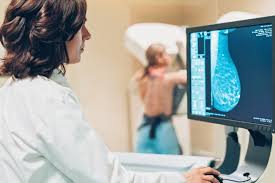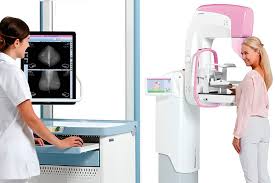Mammography: what is it and why is it performed?
Mammography is an x-ray imaging technique used to examine the breasts for early detection of cancer and other diseases. It is used as a diagnostic and screening tool. Let's learn more about what mammography is and how it is done, as well as when you should undergo mammography.
How mammography is done
Most women unfamiliar with this procedure are interested in how mammography is performed. The study is aimed at obtaining an X-ray image of the tissues and structures of the breast. During the procedure, the patient's breast is placed on a support, pressed with a plate-spatula. The machine ejects a small amount of X-rays. The radiation passes through the gland and is directed to a detector on the opposite side. The detector may be a photographic plate that captures the image on film or a solid element that transmits electronic pulses to a computer to produce a digital image. The resulting mammography image is called a mammogram.
On a film mammogram, low-density tissue, such as fat, appears translucent, with darker shades of gray approaching a black background. And areas of dense tissue, such as connective and glandular tissue or tumors, appear whiter against a gray background. A standard mammogram takes both an overhead view and a side view of each breast, although additional views may be taken if the doctor is concerned about suspicious areas.

What is digital mammography?
Digital mammography uses the same X-ray technology as conventional mammograms, but instead of using film to record the X-ray pattern passing through the breast, solid-state detectors are needed. These convert the X-rays passing through them into electronic signals that are sent to a computer. The computer then converts these electronic signals into images that can be displayed on a monitor and also saved for later use.
Digital mammography is an examination that beats film mammography with these features:
changing the contrast of the image for greater clarity;
computerized detection of abnormalities;
easy transfer of digital files to other examiners for a second opinion.
In addition, digital mammograms reduce the need for repeat images, which are common with film mammography due to improper exposure methods or film developing problems. As a result, digital mammography may result in reduced x-ray exposure. To date, there is no evidence that digital mammography is better than film mammography for reducing a woman's risk of dying from breast cancer. However, digital screening may be more accurate for detecting cancer in younger women or women with dense breasts.
What does mammography equipment look like?
A mammograph is equipment that is a box with an x-ray tube. It is used only for breast scans and has special protection to eliminate exposure to X-rays outside the breast. The mammograph is supplemented with a knot that holds and compresses the breast so that the doctor can take pictures from different angles. The details of how mammography is performed have already been mentioned above.
What results mammography will show
What does a breast mammogram show? The radiologist will scrutinize the mammogram to look for areas of high density or areas of unusual configuration that look different from normal tissue. These areas can represent many different types of abnormalities, including:
cancerous tumors;
non-cancerous growths called benign tumors;
fibroadenomas;
complex cysts.
The doctor looks at the size, shape, and contrast of the abnormal area, as well as the appearance of the edges or borders of such an area, assessing the likelihood that the mass is malignant.
A mammogram may also show tiny fragments of calcium, called microcalcifications, which appear as very bright dots on the mammogram. Although they are usually benign, areas of microcalcifications can sometimes signal the presence of a certain type of cancer.
If a mammogram shows a suspicious area, the doctor may refer the patient for additional tests, including a biopsy.
Risks of mammography
Because breast mammography uses X-rays to produce images of the breasts, patients are exposed to small amounts of ionizing radiation. But understanding what breast mammography is and what mammography shows can help overcome fears of radiation. For most women, the benefits of regular mammograms as a method of early cancer detection outweigh the risks associated with this amount of radiation. A surgeon can remove a detected mass before it spreads and requires more aggressive treatment such as chemotherapy.


